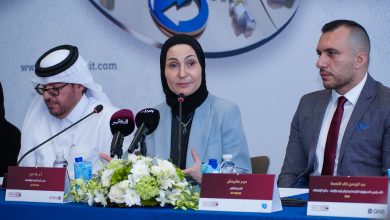COP26: Qatar Has Outstanding Achievements, Ambitious Plans, Extensive International Cooperation
مؤتمر تغير المناخ: دولة قطر إنجازات بارزة وخطط طموحة وتعاون دولي واسع
QNA
Doha: The issue of climate change is of great importance and a top priority at the forefront of the international agenda, as it has a very dangerous impact on the planet and the lives of humans, plants and animals, and other variables and risks that are near, medium and far in impact and damage.
From this standpoint, the State of Qatar and the world have realized the importance of this issue, and the need for a sustainable healthy environment as a human right, at a time when global climate negotiations and biodiversity summits have demonstrated global readiness to move in this direction, which the State of Qatar constantly affirms its strong commitment to contribute to.
The Qatari position in support of international efforts to combat climate change highlights the allocation of the Ministry of Environment and Climate Change, among its competencies, to limit emissions that cause climate change, which confirms the continuous keenness and unlimited support given by HH the Amir Sheikh Tamim bin Hamad Al-Thani for the issue of the environment and climate.
This keenness is also evidenced by HH the Amir’s participation in the 26th session of the Conference of the Parties to the United Nations Framework Convention on Climate Change (COP26), in the Scottish city of Glasgow.
Within the framework of the meeting that HH the Amir held with HE Prime Minister of Britain Boris Johnson on the sidelines of the conference, Qatar Foundation for Education, Science and Community Development (QF) and Rolls-Royce Motor Cars Automobile company announced that they have entered into a long-term partnership to create a global centre for climate technology innovation.
The State of Qatar recently signed a memorandum of understanding (MoU) with the Global Green Growth Institute (GGGI) on cooperation in the field of adaptation to climate change and green growth. Qatar is a founding member of this institute, which helps developing countries to follow development strategies based on the foundations of sustainability. This confirms the continuous interest and support for the issue of environment and climate change, which has placed the State of Qatar in a distinguished position as an active and vital member in all international and regional organizations concerned with environment and climate, and its contribution to support the efforts of developing countries to combat the effects of climate change.
Qatar’s keenness on the issue of environment and climate change is also evident in the appointment of a Special Envoy of the Minister of Foreign Affairs for Climate Change and Sustainability, and in Qatar’s inclusion of the issue of environment and climate change in its National Vision 2030, which is in line with the United Nations Sustainable Development Goals (SDGs) and the country’s ambition to reach a leadership position in the region through the implementation of many projects and initiatives that contribute to the efforts made, to reduce air pollutants and carbon dioxide emissions, and increase reliance on renewable energy sources.
In a related context, on Oct. 28, the State of Qatar launched the Qatar National Environment and Climate Change Strategy, which contributes with the National Climate Change Action Plan 2030 to achieve a balance between the urgent need to work in the field of climate change and environmental protection, and the need to promote social and economic development in a sustainable economy based primarily on the export of liquefied natural gas and related products.
The strategy affirms the State’s commitment to protecting and promoting the environment and establishing harmony between the economic, social and environmental components in line with the objectives of the Qatar’s National Vision 2030, in addition to the relentless pursuit to secure Qatar’s environment for current and future generations, as well as the unlimited great interest in the phenomenon of climate change as one of the most important environmental issues at the national and global levels, given its risks and challenges that require strengthening the global response and coordinating urgent cooperation between the concerned parties.
The Qatar National Environment and Climate Change Strategy covers 5 areas: greenhouse gas emissions, air quality, biodiversity, water, circular economy, waste management and land use, with the development of a governance system to implement the strategy, to reach the specific goals by 2030, including reducing greenhouse gas emissions by 25 percent, establishing 30 air quality monitoring stations by 2023, and increasing the number of biodiversity reserves.
The strategy is characterized by being integrated in terms of land use, and it aims to improve agricultural productivity and sustainability in line with the Qatar Food Security Strategy, while using land more efficiently will improve the quality of life in Qatar by providing public transport and green spaces. The strategy also aligns with the sustainable development goals of the United Nations and Qatar’s ambition to reach a leadership position in the region, through the implementation of many projects and initiatives that contribute to efforts to reduce air pollutants and carbon dioxide emissions, and increase reliance on renewable energy sources. Above all, the strategy is the result of joint efforts between the government, the private sector, civil society and Qatari citizens, aimed at achieving great success and providing a more sustainable future for the Qatari people.
Assistant Undersecretary for Environmental Affairs at the Ministry of Environment and Climate Change Eng. Hassan Jumaa Al Mohannadi said in a statement to Qatar News Agency (QNA) that with regard to the first pillar of greenhouse gas emissions, for example, international cooperation will be a key factor in reducing emissions. He pointed out that the State of Qatar, to achieve its pledge to reduce greenhouse gas emissions by 25 percent until 2030 compared to the usual path, will adopt low-carbon technologies and solutions based on natural materials, explaining that reducing greenhouse gas emissions will bring many benefits, such as improving the quality of air.
Eng. Hassan Jumaa Al Mohannadi stressed that this strategy constitutes a starting point for the next station of the journey aimed at achieving harmony and balance between the economy, people and nature and also the focal point for unifying and expanding efforts to ensure optimal protection of the ecosystem, and is the cornerstone for managing Qatar’s water resources to achieve sustainability, as well as its contribution to improving waste management practices, which will enable a more circular economy, pointing out that when developing the strategy, great attention was paid to establishing a strong governance structure that would constitute a key enabling factor to ensure the success of its implementation. He stressed that the effective implementation of this strategy will be a model for other countries to follow to move toward a more sustainable future.
In this context, the State of Qatar’s efforts go beyond reducing climate change and protecting the habitats and species of different animals, as it is looking forward to the effective use of the land and the optimization of the available water sources, as well as the effective management of resources and waste in order to achieve a more circular economy.
The State of Qatar has assumed its responsibility as an active partner in the international community to confront the phenomenon of climate change. In 2012, it hosted the eighteenth session of the Conference of Parties (COP 18) to the United Nations Framework Convention on Climate Change (UNFCCC) and the Doha Carbon and Energy Forum (DCEF), in which international experts participated to develop policy recommendations for that sector and governments on climate change, alternative energy, carbon capture and storage (CCS). Qatar also spared no effort in the success of the Paris Agreement on climate change negotiations in 2015.
By signing the Paris Agreement for climate change, collectively with other world leaders in 2015, Qatar pledged to commit to reducing global temperatures to much less than 2 degrees Celsius, and to strive to limit global warming to no more than 1.5 degrees Celsius. This formalized Qatar’s international commitments to reduce greenhouse gas emissions, combat climate change and protect the environment, so that the commitment to preserving the environment is an integral part of the country’s Constitution, and it is one of the main pillars identified in the framework of its National Vision, and is given a top priority in the first and second national development strategy.
Qatar’s progress in its efforts to address the adverse and negative impacts of climate change reflects its clear commitment to its pledges under the Paris Agreement, in full accordance with the objectives set out in Qatar National Vision 2030 (QNV 2030) and other strategies and plans at the national level, including the National Climate Change Action Plan 2030, which outlines programs and plans developed by each sector and the actions expected to be implemented to achieve the desired goals, with the oil and gas sector being the largest contributor to emission reduction efforts, however, all other sectors and stakeholders have identified their ambitious contributions to achieve the targeted goals.
The National Climate Change Action Plan 2030 identifies more than 300 adaptation measures, reflecting Qatar’s resilience to the impacts of climate change, while the adoption of the national action framework and the formation of the National Climate Change Committee ensure that these programs and plans are implemented within a well-established framework based on the principles of governance, transparency, and accountability.
Qatar is also aware that many of the impacts of climate change will continue for many decades to come and it is difficult to find immediate solutions, so it is necessary to adapt to these impacts, and cooperate to reduce their impact on societies, the environment and the economy, which means that this adaptation is an essential element of Qatar’s National Environment and Climate Change Strategy.
At the local level, Qatar has also implemented several environmental projects and initiatives to reduce the impacts of climate change, among them is the One Million Trees Planting Initiative launched in 2019, which has so far completed the planting of more than half a million trees, while the remaining number will be planted before the FIFA World Cup Qatar 2022.
Qatar is currently implementing a new monitoring, reporting, and verification system that provides decision makers with the right information in a timely manner, allowing informed decisions to be made on a range of climate and environmental issues. The system will also help guide information provided by Qatar to the UNFCCC and other supranational bodies.
With regard to major achievements and initiatives, Qatar has already succeeded in implementing programs and projects aimed at reducing greenhouse gas emissions, improving environmental protection methods, adapting to the impacts of climate change, optimizing water use in order to reduce the loss of desalinated water and encourage recycling water and its reuse, improving air quality, enhancing gas and energy efficiency, recycling waste, and increasing green spaces. In the same context, in order to achieve the long-term environmental objectives, Qatar has developed a full set of fixed goals, the most important of which are renewable energy to generate 200 megawatts of solar energy to reduce emissions and push investments towards cleaner options.
In light of relying largely on the energy sector to drive economic growth and achieve social development, Qatar is keen to find the right balance between providing clean energy and making it available at an affordable cost to all, while at the same time committing to being responsible towards the environment and promoting the preservation of natural resources constantly.
Qatar Energy (QE) plans to reduce the carbon intensity of LNG facilities by 25 percent by 2030, to reach net zero emissions from routine ignition in natural gas production, as well as set a methane intensity target of 0.2 percent. In order to reduce greenhouse gas emissions from its operations, QE has invested heavily in advanced technology to increase energy efficiency and reduce emissions from natural gas ignition, and plans to begin relying on renewable and clean energy sources in the coming years.
The State of Qatar is proud of these achievements, while recognizing that it still has a lot of work to do to successfully implement Qatar’s National Environment and Climate Change Strategy and the National Climate Change Action Plan 2030.
As the host of the FIFA World Cup 2022, the State of Qatar has affirmed on more than one occasion and forum its commitment to organizing an environmentally friendly tournament and the first carbon-neutrality tournament through the use of solar energy in stadiums, and the use of energy- and water-saving cooling and lighting technology.
The State of Qatar, under the directives of the wise leadership, seeks to occupy high ranks in the public transport sector and the use of environmentally friendly cars. In this regard, one of the ambitious plans of the Ministry of Transport is that, before the start of the FIFA World Cup Qatar 2022, between 20 to 25 percent of public transport in the country will be environment-friendly, will use clean energy and enjoy the best safety standards and a high degree of quality and efficiency.
Environmentally friendly transport options will reduce the carbon footprint of the tournament and build a sustainable legacy for future generations, as the provision of clean energy-powered transport solutions, such as the Doha Metro, Tram network, and energy-efficient buses, will reduce emissions from tournament operations, while the proximity of the distances in the Qatar World Cup ensures that fans, players, administrators and others do not need to fly within Qatar, which reduces the environmental impact of the tournament compared to previous editions of the World Cup.
On the external level, the State of Qatar’s continuous interest and support for the issue of the environment and climate change is not only limited to the national level, but also includes supporting the efforts of developing countries to combat the effects of climate change, including HH the Amir’s announcement in his speech at the Climate Action Summit in 2019, of the State of Qatars contribution of $100 million to support small island developing states and least developed countries, to deal with climate change, natural hazards and environmental challenges, and to build the capacity to counter their destructive effects.
All of this proves the great and pivotal role played by the State of Qatar in the field of cooperation with international organizations and bodies concerned with environmental affairs and climate change, especially since the State of Qatar was one of the first countries to accede to the United Nations Framework Convention on Climate Change in 1996, the Kyoto Protocol in 2005 and the Paris Agreement in 2016. Furthermore, the State of Qatar is also a member of the International Renewable Energy Agency (IRENA), which supports countries in their transition to a sustainable energy future, knowing that Qatar hosted the eighteenth Conference of the Parties (COP18) in 2012, which is considered one of the global negotiations on climate change that contributed to reaching the Paris Agreement on climate change in 2015.
Undoubtedly, the phenomenon of climate change is one of the serious challenges in this era, and it is a vital task that lies first in the coexistence of all in harmony with nature, and at the same time it raises many problems that intertwine in their economic, environmental and social dimensions. It is incumbent upon the developed and developing countries alike to give them great care they deserve and redouble efforts to confront their challenges and limit their repercussions, with all parties fulfilling their commitments and responsibilities and implementing their commitments enshrined in international agreements in this regard.
قنا
الدوحة: تكتسب قضية التغير المناخي أهمية كبرى وأولوية قصوى في صدر الأجندة الدولية، لما ينطوي عليها من تأثير بالغ الخطورة على كوكب الأرض وحياة البشر والنبات والحيوان، وغير ذلك من المتغيرات والمخاطر قريبة ومتوسطة وبعيدة التأثير والضرر.
ومن هذا المنطلق فقد أدركت دولة قطر والعالم أهمية هذه القضية، وضرورة توفر البيئة الصحية المستدامة كحق بشري، في وقت أثبتت فيه المفاوضات المناخية العالمية وقمم التنوع البيولوجي، الاستعداد العالمي للتحرك في هذا الاتجاه، الذي تؤكد دولة قطر باستمرار التزامها القوي بالمساهمة فيه.
ويبرز الموقف القطري الداعم للجهود الدولية في مكافحة التغير المناخي، في تخصيص وزارة للبيئة والتغير المناخي، من ضمن اختصاصاتها الحد من الانبعاثات المسببة للتغير المناخي، ما يؤكد الاهتمام المستمر والدعم اللامحدود الذي يوليه حضرة صاحب السمو الشيخ تميم بن حمد آل ثاني أمير البلاد المفدى – حفظه الله ورعاه – لقضية البيئة والمناخ.
ويدلل على هذا الاهتمام كذلك مشاركة حضرة صاحب السمو الشيخ تميم بن حمد آل ثاني أمير البلاد المفدى في الدورة السادسة والعشرين لمؤتمر الأطراف في اتفاقية الأمم المتحدة الإطارية بشأن تغير المناخ (COP26)، في مدينة غلاسكو الإسكتلندية. وفي إطار اللقاء الذي عقده سموه مع دولة السيد بوريس جونسون رئيس وزراء بريطانيا على هامش انعقاد المؤتمر، أعلنت مؤسسة قطر للتربية والعلوم وتنمية المجتمع، وشركة “رولز-رويس” البريطانية، عن دخولهما في شراكة طويلة الأمد لإنشاء مركز عالمي للابتكار في تكنولوجيا المناخ.
كما وقعت دولة قطر مؤخرا مذكرة تفاهم مع المعهد العالمي للنمو الأخضر، بشأن التعاون في مجال التكيف مع تغير المناخ والنمو الأخضر، علما بأن قطر عضو مؤسس في هذا المعهد الذي يساعد البلدان النامية على اتباع استراتيجيات تنمية مبنيَّة على أسس الاستدامة، ما يؤكد الاهتمام والدعم المستمر لقضية البيئة وتغير المناخ، والذي وضع دولة قطر في مكانة مميزة كعضو فاعل وحيوي في جميع المنظمات الدولية والإقليمية المعنية بالبيئة والمناخ، ومساهمتها في دعم جهود البلدان النامية لمكافحة التأثيرات المترتبة على تغير المناخ.
ويتضح اهتمام قطر بقضية البيئة والتغير المناخي أيضا في تعيين مبعوث خاص لوزير الخارجية لشئون التغير المناخي والاستدامة، وفي تضمين قطر قضية البيئة والتغير المناخي في رؤيتها الوطنية 2030، التي تتوافق مع أهداف التنمية المستدامة للأمم المتحدة وطموح الدولة لبلوغ مركز قيادي في المنطقة من خلال تنفيذ العديد من المشاريع والمبادرات التي تساهم في الجهود المبذولة، لخفض الملوثات الهوائية وتقليل انبعاثات ثاني أكسيد الكربون وزيادة الاعتماد على مصادر الطاقة المتجددة.
وفي سياق ذي صلة، أطلقت دولة قطر في 28 أكتوبر الماضي /استراتيجية قطر الوطنية للبيئة والتغير المناخي/ والتي تساهم مع خطة العمل الوطنية للتغير المناخي 2030، في تحقيق التوازن بين الحاجة الملحة إلى العمل في مجال تغير المناخ وحماية البيئة، وضرورة تعزيز التنمية الاجتماعية والاقتصادية المستدامة في اقتصاد يقوم أساسا على تصدير الغاز الطبيعي المسال والمنتجات ذات الصلة.
وتؤكد الاستراتيجية التزام الدولة بحماية وتعزيز البيئة وتأسيس تجانس بين المكونات الاقتصادية والاجتماعية والبيئية تماشيا مع مستهدفات رؤية قطر الوطنية 2030، بجانب السعي الدؤوب لتأمين بيئة قطر للأجيال الحالية والمستقبلية، وكذا الاهتمام الكبير غير المحدود بظاهرة التغير المناخي باعتباره أحد أهم المعضلات البيئية على المستويين الوطني والعالمي، ونظراً لمخاطره وتحدياته التي تستوجب تعزيز الاستجابة العالمية وتنسيق التعاون الملح بين الأطراف المعنية.
وتغطي استراتيجية قطر الوطنية للبيئة والتغير المناخي 5 مجالات هي انبعاثات الغازات الدفيئة، وجودة الهواء، والتنوع البيولوجي، والمياه والاقتصاد الدائري، وإدارة النفايات واستخدام الأراضي، مع وضع نظام حوكمة لتنفيذ الاستراتيجية، للوصول للأهداف المحددة بحلول عام 2030، ومن ذلك خفض انبعاثات الغازات الدفيئة بنسبة 25 بالمئة، وإنشاء 30 محطة لرصد جودة الهواء بحلول عام 2023، وزيادة عدد المحميات فيما يتعلق بالتنوع البيولوجي.
وتتميز الاستراتيجية بكونها متكاملة من حيث استخدام الأراضي، وهي تهدف إلى تحسين الإنتاجية الزراعية والاستدامة بما يتماشى من استراتيجية قطر للأمن الغذائي، في حين أن استخدام الأراضي بكفاءة أكبر سيرتقي بجودة الحياة في قطر من خلال تأمين وسائل مواصلات عامة ومساحات خضراء . كما تتوافق مع أهداف التنمية المستدامة للأمم المتحدة وطموح دولة قطر لبلوغ مركز قيادي في المنطقة، من خلال تنفيذ العديد من المشاريع والمبادرات التي تساهم في الجهود المبذولة لخفض الملوثات الهوائية وتقليل انبعاثات ثاني أكسيد الكربون، وزيادة الاعتماد على مصادر الطاقة المتجددة، وفوق كل ذلك فالاستراتيجية نتيجة الجهود المشتركة بين الحكومة والقطاع الخاص والمجتمع المدني والمواطنين القطريين والهادفة إلى تحقيق النجاح الباهر وتوفير مستقبل أكثر استدامة للشعب القطري.
ويقول المهندس حسن جمعة المهندي وكيل الوزارة المساعد لشئون البيئة بوزارة البيئة والتغير المناخي في تصريح لوكالة الأنباء القطرية /قنا/، إنه فيما يتعلق بالركيزة الأولى الخاصة بانبعاثات غازات الدفيئة مثلا، فإن التعاون الدولي سيشكل عاملا أساسيا لخفض الانبعاثات، لافتا إلى أن دولة قطر لتحقيق ما تعهدت به بخفض انبعاثات غازات الدفيئة بنسبة 25 بالمئة حتى عام 2030 مقارنة بالمسار المعتاد، ستتبنى تقنيات منخفضة الكربون وحلول تعتمد على المواد الطبيعية، موضحا أن تخفيض انبعاثات غازات الدفيئة سيتأتى عنه العديد من الفوائد كتحسين جودة الهواء المحيط الخارجي والداخلي مثلا.
وأكد أن هذه الاستراتيجية تشكل نقطة انطلاق للمحطة التالية من “رحلتنا الهادفة إلى تحقيق التناغم والتوازن بين الاقتصاد والشعب والطبيعة” ونقطة الارتكاز أيضا لتوحيد وتوسيع الجهود لضمان الحماية المثلى للنظام البيئي، كما تعد حجر الأساس لإدارة موارد قطر المائية بما يحقق استدامتها، فضلا عن إسهامها في تحسين ممارسات إدارة النفايات، ما سيمكن من تعزيز الاقتصاد الدائري، لافتا إلى أنه عند تطوير الاستراتيجية تم إيلاء اهتمام كبير لإرساء هيكل حوكمة قوي من شأنه أن يشكل عامل تمكين أساسي لضمان النجاح في تنفيذها، وأكد أن التنفيذ الفعال لهذه الاستراتيجية سيكون نموذجا تحتذي به سائر الدول لتوجيه دفة السفينة نحو مستقبل أكثر استدامة.
وفي هذا السياق فإن جهود دولة قطر تتجاوز ما هو أبعد من تقليل التغير المناخي وحماية موائل وفصائل الحيوانات المختلفة، الى التطلع كذلك نحو الاستخدام الفعال للأرض وتحقيق الاستفادة المثلى من مصادر المياه المتاحة والإدارة الفعالة للموارد والنفايات وصولا الى تحقيق اقتصاد أكثر دائرية .
لقد اضطلعت دولة قطر بمسؤوليتها كشريك فاعل في المجتمع الدولي لمواجهة ظاهرة التغير المناخي، ففي عام 2012 استضافت الدورة الثامنة عشرة لمؤتمر الدول الأطراف في اتفاقية الأمم المتحدة الإطارية حول تغير المناخ، كما استضافت منتدى الدوحة للكربون والطاقة، الذي شارك فيه خبراء دوليون لوضع توصيات في مجال السياسات العامة لذلك القطاع وللحكومات بشأن تغير المناخ، والطاقة البديلة، وجمع الكربون وتخزينه، كما أن دولة قطر لم تدخر جهدًا في إنجاح مفاوضات اتفاق باريس للمناخ عام 2015.
وتعهدت دولة قطر من خلال توقيعها على اتفاق باريس للمناخ بشكل جماعي مع قادة العالم الآخرين عام 2015، على الالتزام بخفض درجات العالم الحرارة العالمية إلى ما هو أقل بكثير من درجتين مئويتين، والسعي الجاهد للحد من الاحتباس الحراري بحيث لا يتجاوز 1.5 درجة مئوية، ليضفي طابعاً رسمياً على التزامات قطر الدولية بخفض انبعاثات الغازات الدفيئة، ومكافحة تغير المناخ، وحماية البيئة، ليشكل الالتزام بالحفاظ على البيئة جزءاً لا يتجزأ من دستور دولة قطر، وهو إحدى الركائز الأساسية المحددة في إطار رؤيتها الوطنية، ويتم إيلاؤه أولوية قصوى في استراتيجية التنمية الوطنية الأولى والثانية.
ويعكس التقدم الذي أحرزته قطر في جهودها في مواجهة الآثار الضارة والسالبة للتغير المناخي، التزامها الواضح بتعهداتها بموجب اتفاق باريس، بما يتوافق بشكل كامل مع الأهداف المحددة في رؤية قطر الوطنية 2030 وغيرها من الاستراتيجيات والخطط على المستوى الوطني، ومنها خطة العمل الوطنية للتغير المناخي 2030، التي تحدد البرامج والخطط الموضوعة من قبل كل قطاع والإجراءات المتوقع تنفيذها لتحقيق الأهداف المرجوة، حيث يعتبر قطاع النفط والغاز أكبر مساهم في الجهود الآيلة إلى خفض الانبعاثات، ومع ذلك فقد حددت جميع القطاعات الأخرى وأصحاب المصلحة المعنيين مساهماتها الطموحة لبلوغ الغايات المستهدفة .
وتحدد خطة العمل الوطنية للتغير المناخي 2030 أكثر من 300 إجراء في إطار تدابير التكيف، مما يعكس قدرة دولة قطر على الصمود في مواجهة التأثيرات المترتبة على تغير المناخ، بينما يضمن اعتماد إطار العمل الوطني وتشكيل اللجنة الوطنية للتغير المناخي تنفيذ هذه البرامج والخطط ضمن إطار راسخ يقوم على مبادئ الحوكمة والشفافية والمساءلة.
وتدرك قطر كذلك أن العديد من التأثيرات المترتبة على تغير المناخ ستستمر لعقود عديدة قادمة ومن الصعب إيجاد الحلول الفورية لها، مما يتعين معه التكيف مع هذه التأثيرات، وأن يتعاون الجميع معاً من أجل الحد من تأثيرها على المجتمعات والبيئة والاقتصاد ، مما يعني أن هذا التكيف يشكل عنصراً أساسياً في إستراتيجية قطر الوطنية للبيئة والتغير المناخي .
وعلى المستوى المحلي أيضا نفذت قطر العديد من المشاريع والمبادرات البيئية، للحد من تأثيرات تغير المناخ، من بينها على سبيل المثال، مبادرة زراعة مليون شجرة التي تم إطلاقها في العام 2019 ، وأنجزت حتى الآن زراعة أكثر من نصف مليون شجرة، فيما سيتم زراعة العدد المتبقي قبل بطولة كأس العالم لكرة القدم 2022 في قطر .
وتنفذ قطر حالياً نظاماً جديداً للرصد والإبلاغ والتحقق يزود صانعي القرار بالمعلومات الصحيحة في الوقت المناسب، مما يتيح اتخاذ قرارات مستنيرة بشأن مجموعة من القضايا والمسائل المتعلقة بالمناخ والبيئة. وسيساعد هذا النظام أيضاً في الاسترشاد بالمعلومات المقدمة من قطر إلى اتفاقية الأمم المتحدة الإطارية بشأن تغير المناخ وغيرها من الهيئات فوق الوطنية.
وفيما يعنى أيضا بالإنجازات والمبادرات الرئيسية، فقد نجحت قطر بالفعل في تنفيذ برامج ومشاريع تهدف إلى الحد من انبعاثات الغازات الدفيئة، وتحسين سبل الحماية البيئية، والتكيف مع التأثيرات المترتبة على تغير المناخ، والاستخدام الأمثل للمياه من أجل التقليل من فقدان المياه المحلاة والتشجيع على إعادة تدوير المياه وإعادة استخدامها، وتحسين جودة الهواء، وتعزيز كفاءة استخدام الغاز والطاقة، وإعادة تدوير المخلفات، وزيادة المساحات الخضراء. وفي السياق ذاته، وتحقيقًا لأهدافنا البيئية طويلة الأجل، وضعت دولة قطر مجموعة متكاملة من الأهداف الثابتة، أهمها تلك المتعلقة بالطاقة المتجددة لتوليد 200 ميغاواط من الطاقة الشمسية لخفض الانبعاثات ودفع الاستثمارات في اتجاه خيارات أنظف.
وفي ظل الاعتماد إلى حد كبير على قطاع الطاقة في دفع عجلة النمو الاقتصادي وتحقيق التنمية الاجتماعية، تحرص قطر على إيجاد التوازن الصحيح بين توفير الطاقة النظيفة وإتاحتها بتكلفة ميسورة للجميع، مع الالتزام في الوقت نفسه بالمسؤولية تجاه البيئة وتعزيز الحفاظ على الموارد الطبيعية باستمرار.
وتعتزم قطر للطاقة خفض كثافة الكربون في منشآت الغاز الطبيعي المسال بنسبة 25 بالمئة بحلول عام 2030، وبلوغ هدف الصفر في الانبعاثات الناتجة عن عمليات الإشعال الروتيني في إنتاج الغاز الطبيعي، فضلاً عن خفض كثافة الميثان المرجحة بنسبة 0,2 بالمئة بحلول عام 2025. ومن أجل تخفيف انبعاثات الغازات الدفيئة الناتجة عن عملياتها، استثمرت شركة قطر للطاقة بكثافة في التكنولوجيا المتقدمة لزيادة كفاءة الطاقة وتقليل الانبعاثات الناتجة من إشعال الغاز الطبيعي، وهي تخطط لبدء الاعتماد على مصادر الطاقة المتجددة والنظيفة خلال السنوات القادمة.
وتفخر دولة قطر بهذه الإنجازات، وتدرك في نفس الوقت إدراكاً راسخاً أنه مازال أمامها الكثير من العمل الذي يتعين عليها القيام به، من أجل تحقيق نجاح تنفيذ استراتيجية قطر الوطنية للبيئة والتغير المناخي وخطة العمل الوطنية للتغير المناخي 2030.
وبصفة دولة قطر مستضيفة لبطولة كأس العالم لكرة القدم عام 2022، فقد أكدت في أكثر من مناسبة ومحفل التزامها بتنظيم بطولة صديقة للبيئة وأول بطولة “محايدة للكربون” عبر استخدام الطاقة الشمسية في الملاعب، واستخدام تكنولوجيا تبريد وإضاءة موفرة للطاقة والمياه.
وتسعى دولة قطر في ظل توجيهات القيادة الحكيمة الى أن تحتل مراتب عليا في قطاع النقل العام واستخدام السيارات الصديقة للبيئة، وفي هذا الصدد فإن من الخطط الطموحة لوزارة المواصلات ، أن تصبح وقبل انطلاق بطولة كأس العالم لكرة القدم 2022، بين 20 إلى 25 بالمائة من وسائل النقل العام في الدولة صديقة للبيئة تعمل بالطاقة النظيفة وتتمتع بأفضل معايير السلامة وعلى درجة عالية من الجودة والكفاءة.
ومن شأن خيارات النقل الصديقة للبيئة الحد من الأثر الكربوني للبطولة، وبناء إرث مستدام للأجيال المقبلة، حيث أن توفير حلول نقل تعمل بالطاقة النظيفة، مثل مترو الدوحة، وشبكة الترام، والحافلات الموفرة للطاقة، سيؤدي إلى تقليل الانبعاثات الناتجة عن عمليات البطولة، في حين أن تقارب المسافات في مونديال قطر يضمن للمشجعين واللاعبين والإداريين وغيرهم عدم الحاجة إلى رحلات طيران داخل قطر، ما يقلل من الأثر البيئي للبطولة مقارنة بالنسخ السابقة من كأس العالم.
وعلى الصعيد الخارجي ، لم يقتصر اهتمام دولة قطر ودعمها المستمر لقضية البيئة والتغير المناخي فقط على الصعيد الوطني ، بل تعدى ذلك ليشمل دعم جهود البلدان النامية لمكافحة التأثيرات المترتبة على تغير المناخ ، ومن ذلك ما أعلن عنه حضرة صاحب السمو أمير البلاد المفدى خلال كلمته في قمة العمل من أجل المناخ عام 2019 ، من مساهمة دولة قطر بمبلغ 100 مليون دولار أمريكي لدعم الدول الجزرية الصغيرة النامية والدول الأقل نموا ، للتعامل مع تغير المناخ والمخاطر الطبيعية والتحديات البيئية ، وبناء القدرة على مواجهة آثارها المدمرة .
وكل ذلك يثبت بما لا يدع مجالا للشك الدور الكبير والمحوري الذي تقوم به دولة قطر في مجال التعاون مع المنظمات والهيئات الدولية المعنية بشؤون البيئة والتغير المناخي، سيما وأن دولة قطر كانت من أوائل الدول التي انضمت لاتفاقية الأمم المتحدة الإطارية بشأن تغير المناخ في العام 1996 وبرتوكول كيوتو في العام 2005 واتفاق باريس في العام 2016 ، كما أن دولة قطر عضو في الوكالة الدولية للطاقة المتجددة (إيرينا) التي تدعم البلدان في انتقالها إلى مستقبل الطاقة المستدامة ، علما أن قطر استضافت مؤتمر الأطراف الثامن عشرCOP18 عام 2012، والذي يُعد أحد محطات المفاوضات العالمية للتغير المناخي التي ساهمت في الوصول لاتفاق باريس بشأن التغير المناخي عام 2015 .
وبلا شك فإن ظاهرة تغير المناخ هي إحدى التحديات الخطيرة في هذا العصر ، وهي مهمة حيوية تكمن أولا في تعايش الجميع بانسجام مع الطبيعة ، وتطرح في نفس الوقت إشكاليات عديدة تتشابك في أبعادها الاقتصادية والبيئية والاجتماعية، ما يتعين معه على البلدان المتقدمة والنامية على حد سواء، ايلائها ما تستحقه من عناية بالغة وجهود مضاعفة لمواجهة تحدياتها والحد من تداعياتها، مع وفاء كافة الأطراف بتعهداتها ومسؤولياتها وتنفيذ التزاماتها التي كرستها الاتفاقيات الدولية في هذا الشأن.




